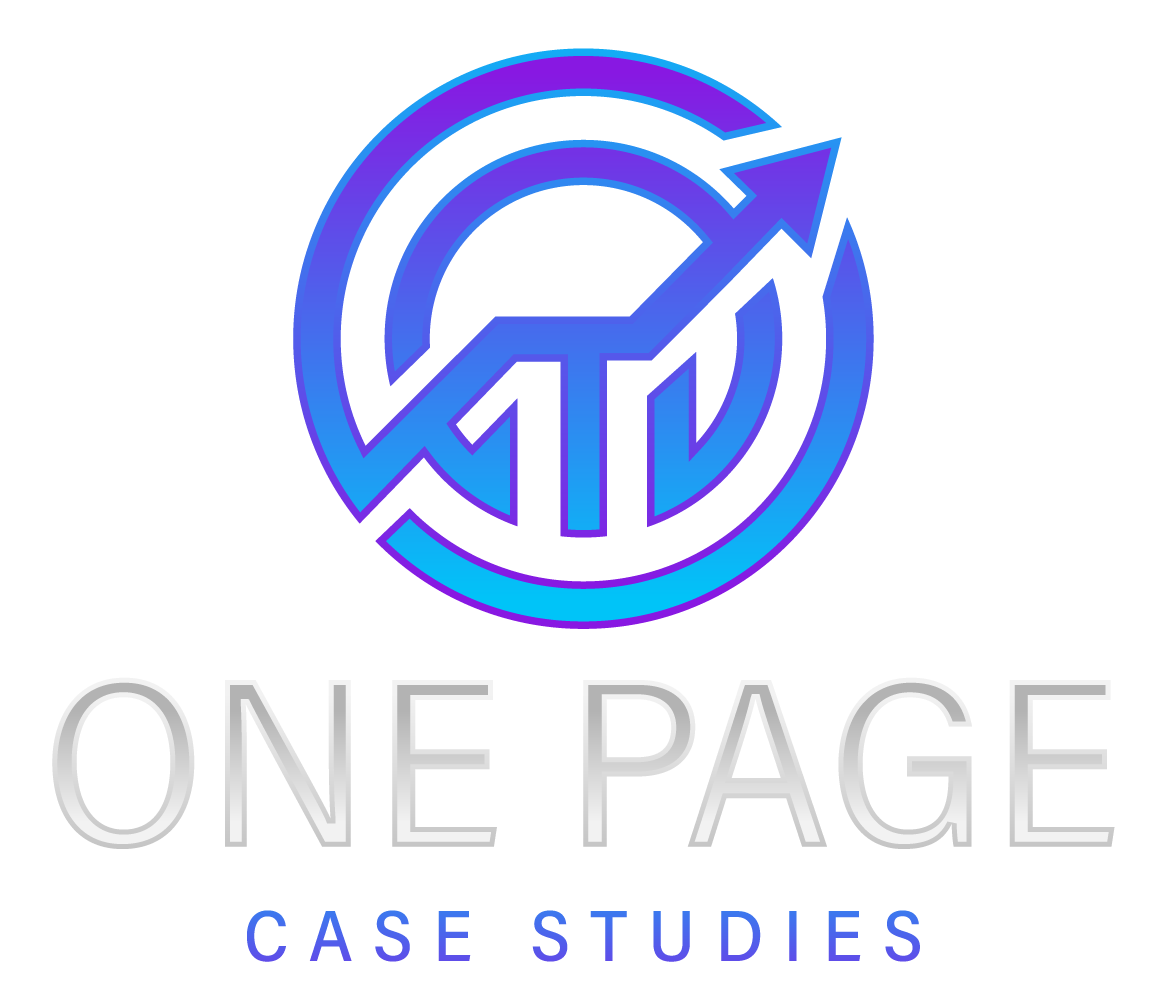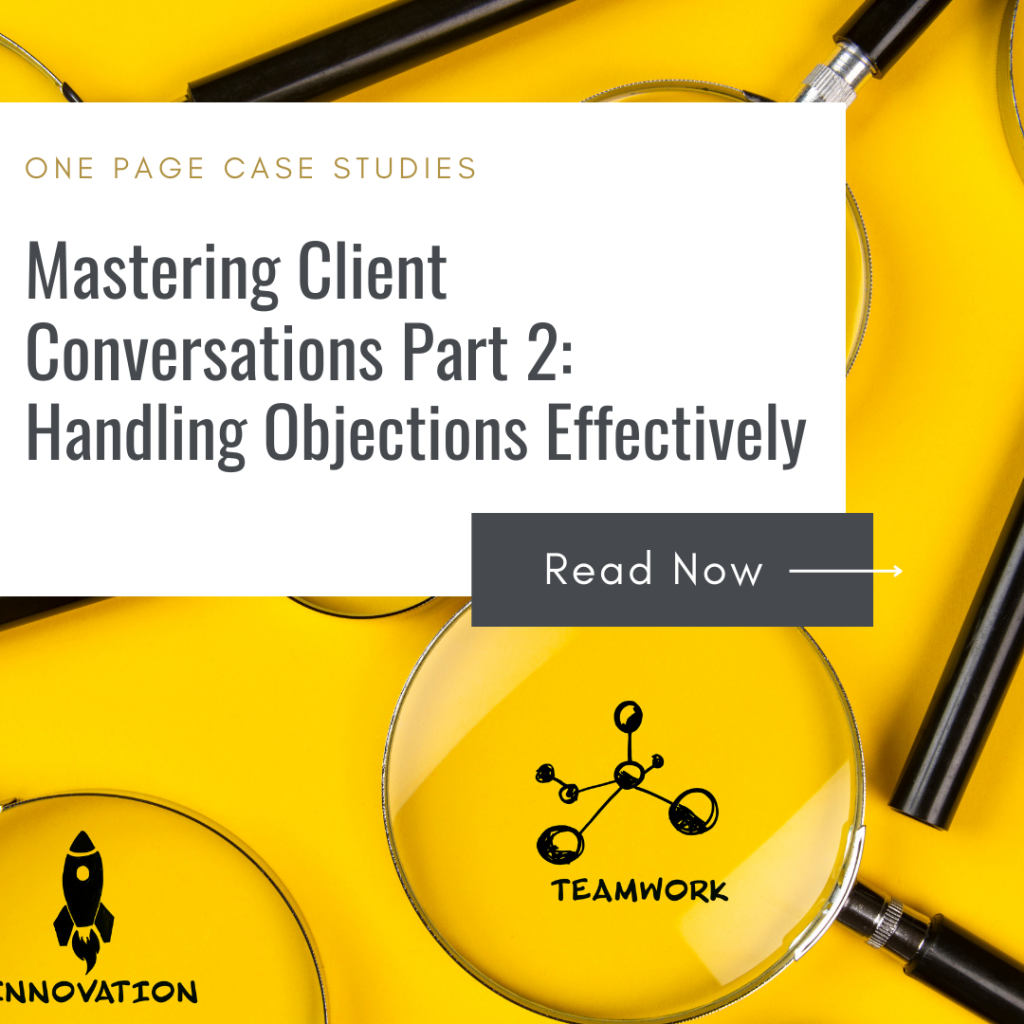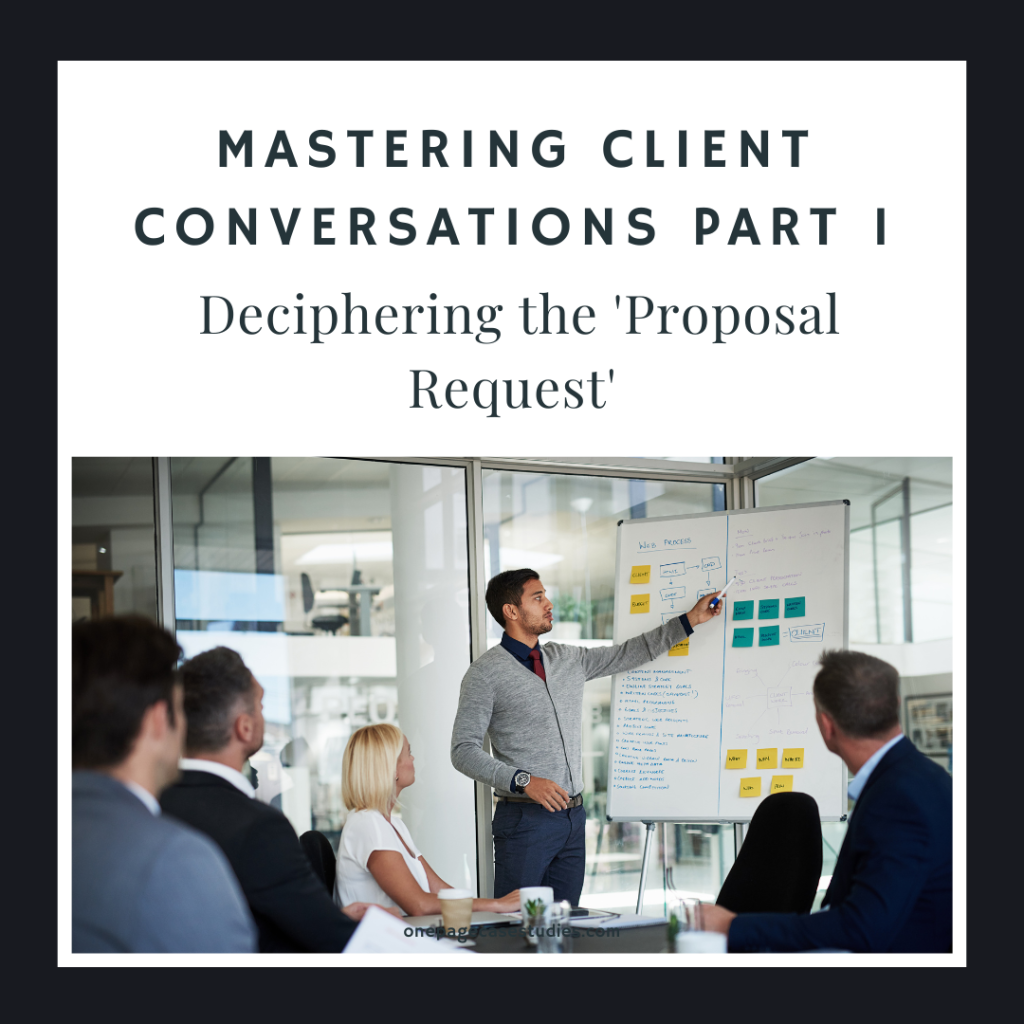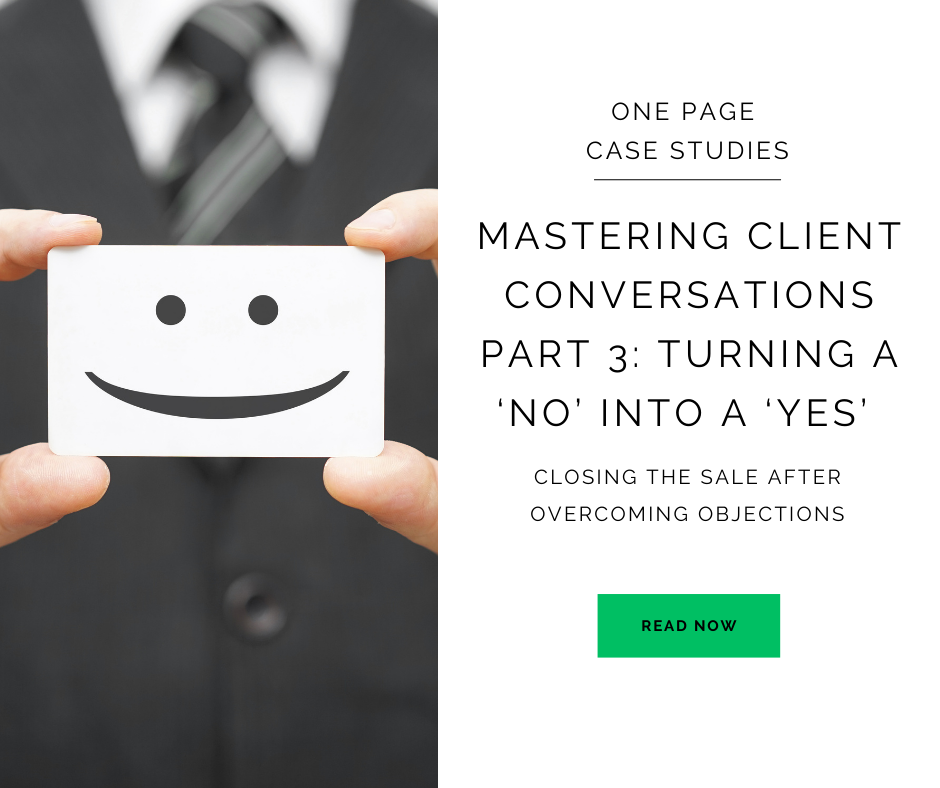Welcome to the second part of our ‘Mastering Client Conversations: From Hesitation to Affirmation’ series. After discussing the interpretation of ‘proposal requests’ in the previous part 1 post, we now explore how to uncover and address hidden client objections.
Remember the scenario we discussed last time when a client asks for a proposal to deflect the conversation? Today, we’re diving deeper into those situations, uncovering the hidden objections that might be lurking beneath.
These objections, if left unaddressed, can prevent a productive business relationship from taking shape. Understanding the true intentions hiding behind a client’s proposal request can save you a great deal of time and prevent misplaced expectations when handling objections.
Understanding the ‘Proposal Request’ Objections
When a client requests a proposal, they might be hiding various objections behind this seemingly straightforward ask. These could range from doubts about the cost and value of your service to concerns about timing or readiness to commit.
Recognizing these underlying objections is the first step to turning a tentative conversation into a committed collaboration.

The Art of Handling Hidden Objections
Detecting hidden objections requires active listening and a deep understanding of your clients’ needs.
Objections are often concealed in the unsaid or in-between lines. By asking open-ended questions that allow your clients to express their thoughts and concerns, you can encourage them to share what’s really holding them back.
The Pivotal Role of Empathy in Addressing Objections
Empathy is more than just a buzzword; it’s a cornerstone of effective client communication and key to unmasking and addressing hidden objections. Empathy allows us to step into our clients’ shoes, genuinely understand their concerns, and respond in a way that acknowledges their feelings and perspectives.
This validation can build a bond of trust, a vital element in converting a prospect into a client. When applied effectively in client conversations, empathy serves five critical roles:
- Empathy Builds Trust: By showing that you genuinely understand and respect your client’s concerns, you foster a relationship of trust. This trust can be a determining factor in the client’s decision to choose your service over others. Trust engenders a sense of security and can often overcome the hesitations a prospect might have in committing to your service.
- Empathy Promotes Open Communication: When a client feels heard and understood, they are more likely to open up about their true concerns. This open communication can lead to a better understanding of what’s really behind their objections. For instance, a concern about cost may be less about the actual price and more about uncertainty regarding the return on investment.
- Empathy Leads to Tailored Solutions: Understanding your client’s perspective allows you to tailor your proposal to their specific needs and concerns. A solution that considers their unique situation is more likely to resonate with them. For instance, if a client voices concern about the cost, an empathetic response might be: “I understand that budget is a significant factor in your decision. Let’s explore how our services can provide a strong return on your investment.”
- Empathy Nurtures Long-Term Relationships: Empathy is not just about addressing immediate objections; it’s about cultivating long-term relationships. By consistently demonstrating empathy, you can foster a connection that goes beyond a single transaction, turning clients into loyal advocates for your business.
- Empathy Encourages Personal Growth: On a personal level, practicing empathy can make us better communicators, negotiators, and business owners. It fosters emotional intelligence, a valuable skill in any business setting.
In essence, empathy is a game-changer when it comes to overcoming objections. It paves the way for understanding, trust, and genuine connection—elements that are critical to transforming tentative prospects into committed clients.

Strategies to Overcome Common Objections
Every objection is a new opportunity to present your services in a light that aligns with your client’s needs. The way you respond to these objections can influence the direction of the conversation, potentially transforming uncertainty into agreement. Here are a few general strategies to manage common objections:
- Showcasing Success Stories: If a client questions the value of your services, sharing success stories or customer testimonials can be a powerful tool. These real-life examples not only demonstrate the potential benefits of your services but also offer social proof, which can be particularly persuasive.
- Communicating the Cost of Delay: If the objection is about timing, explain the potential costs associated with delaying the decision. Discuss how early adoption of your services can lead to quicker benefits, while delays might lead to missed opportunities.
- Providing a Customized Approach: If a client feels your services aren’t perfectly aligned with their needs, a tailored approach can alleviate their concerns. Demonstrate your willingness and ability to modify your offerings to fit their specific situation. This shows flexibility and a commitment to their success.
- Addressing Budget Concerns: If cost is a concern, aim to shift the conversation from price to value. Talk about the return on investment (ROI) they can expect and provide examples of how your services have resulted in financial growth for other clients.
- Providing Reassurance: For clients worried about committing to a long-term contract, offering a trial period or flexible contract terms can provide reassurance. This can alleviate their fears and demonstrate your confidence in your services.
These are general strategies, and the effectiveness of each will depend on the specifics of the objection and the client’s unique circumstances. Always remember to listen carefully and respond with empathy, addressing not only the content of the objection but also the concerns and emotions underlying it.
Handling Objections in Digital Marketing, Content Writing, and SEO – and Specifics on How to Overcome Them
While the strategies outlined above provide a general framework for handling objections, it’s often the specific, industry-related concerns that can make or break a deal. In fields such as digital marketing, content writing, and SEO, it’s crucial to acknowledge these unique objections and offer clear, empathetic responses.
Here are a few common objections you may encounter, along with concrete examples of how to address them effectively:
- ROI Uncertainty: Many clients are uncertain about the return on investment they can expect from digital services. In this case, you could say, “I understand your concerns about the ROI. Let me walk you through some case studies that show how our campaigns have delivered a substantial return for our clients. We also have a robust tracking system to provide you with regular updates on the campaign’s performance.”
- “We have an in-house team”: When clients already have an internal team, they might question the need for your services. Here, a possible response is, “Your in-house team is undoubtedly valuable. Our role is not to replace them, but to bring a fresh perspective and specialized expertise to enhance your digital strategies.”
- Concerns about Cost: When clients raise cost objections, a potential response could be, “While our services do have a cost, they are an investment in your online presence and long-term brand visibility. We put in significant work to ensure our content is high quality and our SEO strategies are effective. Let’s explore how these strategies can result in growth for your business.”
- Lack of Immediate Results: If a client is concerned about the time it takes to see results, you might say, “SEO and content marketing are indeed a long game, but they lay the foundation for sustainable online success. Immediate results can fade quickly, but a well-executed long-term strategy offers steady growth and visibility.”
- Previous Negative Experiences: If a client had a negative experience with another agency, you could respond, “I’m sorry to hear about your previous experience. We prioritize clear, frequent communication and set realistic expectations from the start to ensure we’re on the same page. Let’s discuss what we could do differently to ensure a positive experience for you.”
By navigating these industry-specific objections with understanding and adaptability, we can foster trust with our clients and clearly demonstrate the unique value that our services bring.

Turning Objections into Opportunities
Handling objections is not just about overcoming hurdles; it’s a key part of strengthening your client relationships and refining your offerings.
Objections can serve as constructive feedback, offering valuable insights into how you can better meet your clients’ needs. By applying empathy in understanding these objections and strategic problem-solving in addressing them, you can turn potential roadblocks into opportunities for growth.
Embracing this perspective empowers you to continuously evolve in response to your clients’ needs and to drive your business forward.
Turning objections into opportunities involves reframing the way we view these challenges. Instead of seeing an objection as a roadblock, consider it a chance to learn more about your client’s needs and expectations. Each objection gives you a unique insight into your client’s perspective and allows you to adapt your approach to better serve them.
As mentioned throughout this discussion, the key is to listen carefully to your client’s objections, empathize with their concerns, and respond in a way that addresses their needs and alleviates their worries. In doing so, you not only overcome the immediate obstacle, but also build stronger relationships with your clients and continually improve your service offering.
How to Maintain the Conversation after Handling Objections
After addressing an objection, the next step is to subtly steer the conversation forward.
Ask if your response has clarified their concerns and if there are any other issues they would like to discuss. This not only assures them that their concerns are valued, but also gives you an opportunity to uncover any other potential objections.
You might say, “I hope that addresses your concerns about [objection]. Is there anything else that’s holding you back from moving forward?” By framing your question in this way, you can encourage further dialogue, demonstrate your willingness to engage, and keep the conversation productive and forward-moving.
Remember, the goal is not just to address objections as they arise, but also to build an open, trusting conversation where both parties feel heard and valued. This is essential to transforming objections into opportunities for stronger client relationships and business growth.
After successfully addressing a client’s objections, maintaining the momentum of the conversation is key to further progress. Here’s how:
- Reiterate Their Concerns: Briefly summarize the client’s objection and how you’ve addressed it to ensure you’re both on the same page. This reinforces your understanding and shows that you value their concerns.
- Segue Back to the Discussion: Transition back to your main conversation or presentation. You could say something like, “Now that we’ve addressed this concern, let’s go back to discussing the ways our services can support your goals.”
- Invite Further Input: Encourage the client to share more of their thoughts or concerns. This keeps them engaged and allows you to address any remaining objections they may have.
- Propose the Next Steps: Suggest a way forward, such as setting up a future meeting, starting a trial period, or drafting a proposal. This gives direction to the conversation and indicates progress.
By keeping the conversation flowing after addressing objections, you can continue building rapport and trust, taking you one step closer to turning a prospect into a client.
Proactive Measures to Minimize Objections
Throughout this guide, we’ve explored the importance of empathy in addressing objections, strategies for overcoming common objections, how to turn these objections into opportunities, and maintaining the conversation after addressing objections.
Prevention is better than cure, and this holds true for handling objections as well. By clearly articulating your value proposition, maintaining transparency in communication, and anticipating client concerns, you can minimize the likelihood of objections cropping up. This proactive approach saves time, fosters trust, and smooths the path to successful collaborations.
Mastering the art of unmasking and overcoming objections goes beyond winning a single client; it contributes to a healthier, more client-centric business model. As you hone your ability to navigate hidden objections, you’ll find your conversations becoming more productive, your relationships more robust, and your services more attuned to your clients’ needs.
Unmasking hidden objections is a journey, and we’re sure you’ve had your share of experiences on this path. What strategies have you used to uncover and address objections?
Share your insights in the comments below. Your experience could be the stepping stone for someone else’s learning.
We hope that this discussion on uncovering and handling objections, especially hidden ones, will empower you in your client conversations. In the next and final part of this series, we will discuss how to turn a ‘no’ into a ‘yes’ – how to close the sale after overcoming objections. Stay tuned!



